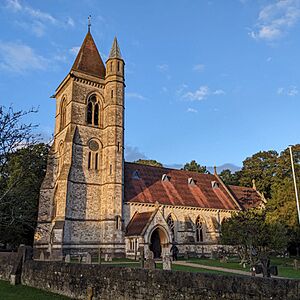St Matthew's Church, Blackmoor facts for kids
Quick facts for kids St Matthew's Church, Blackmoor |
|
|---|---|
 |
|
| Lua error in Module:Location_map at line 420: attempt to index field 'wikibase' (a nil value). | |
| Location | Blackmoor, Hampshire |
| Country | England |
| Denomination | Anglican |
| History | |
| Status | Parish church |
| Dedication | St Matthew |
| Consecrated | 18 May 1869 |
| Architecture | |
| Functional status | Active |
| Heritage designation | Listed building – Grade II* |
| Architect(s) | Alfred Waterhouse |
| Style | Gothic Revival |
| Construction cost | £10,749.10s.11d |
| Specifications | |
| Materials | Stone, flint |
| Administration | |
| Diocese | Portsmouth |
| Province | Canterbury |
St Matthew's Church is a beautiful Anglican church. It is located in the village of Blackmoor, Hampshire, England. This church is very special because it is a Grade II* listed building. This means it is an important historical building that needs to be protected. The church was designed by a famous architect named Alfred Waterhouse. He built it for Roundell Palmer, who later became the 1st Earl of Selborne.
History
Early Beginnings
The first mention of a chapel in Blackmoor is from 1254. That's a very long time ago! This early chapel was connected to the larger parish of Selborne. Records from 1291 also talk about the Selborne church and its chapel.
In 1352, the church leaders of Selborne were in charge of the chapels in Blackmoor and Oakhanger. A century later, in 1462, they even paid for repairs to the Blackmoor chapel.
Building the New Church
Sir Roundell Palmer bought the land in Blackmoor in 1865. He moved there in 1866. There was an old chapel in the village at that time. However, the Palmer family would go to other churches for Sunday services.
After talking with the pastor at St Mary's in Selborne, Palmer decided to build a brand new church in Blackmoor. He also planned to build a vicarage (where the vicar lives), cottages, and schools. He chose Alfred Waterhouse to be the architect for all these new buildings.
The church is built from a pale grey stone called malm stone. This stone came from a local quarry. Finer Bath stone was used for special details and corners.
Inside the church, on the north side of the chancel, there is a special plaque. The village dedicated this plaque to Palmer and his wife. It says: "In gratitude for all the good that under God has come to this parish through their devotion to their Saviour and their love to their fellow men."
Gallery


